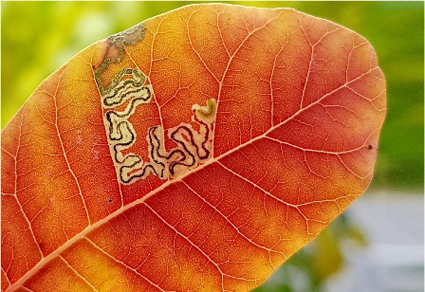Abstract
In this paper, the results of a recent molecular study of the Cotinus-feeding, leaf-mining Simplimorpha promissa (Staudinger) (Lepidoptera: Nepticulidae) are discussed for the first time on the basis of samples collected in Ukraine and Armenia. Newly obtained mtDNA CO1-5' sequences from these countries were compared with previously known sequences from France, Italy, Croatia and Greece. A mitotype network and a Neighbor-Joining tree of twenty-two specimens of S. promissa are provided. They show that the studied specimens from Ukraine and the rest of the European countries are genetically closer to each other than to the examined specimens from Armenia, thereby suggesting the Armenian specimens could represent a sister taxon to the European S. promissa. The study also revealed a significantly large genetic diversity of S. promissa in Ukraine.
References
- Bandelt, H., Forster, P. & Röhl, A. (1999) Median-joining networks for inferring intraspecific phylogenies. Molecular Biology and Evolution, 16 (1), 37–48. https://doi.org/10.1093/oxfordjournals.molbev.a026036
- Dobrynina, V., Stonis, J.R., Diškus, A., Solis, M.A., Baryshnikova, S.V. & Young-Min, S. (2022) Global Nepticulidae, Opostegidae, and Tischeriidae (Lepidoptera): temporal dynamics of species descriptions and their authors. Zootaxa, 5099 (4), 450–474. https://doi.org/10.11646/zootaxa.5099.4.2
- Doorenweerd, C., van Nieukerken, E.J. & Hoare, R.J.B. (2017) Phylogeny, classification and divergence times of pygmy leaf-mining moths (Lepidoptera: Nepticulidae): the earliest lepidopteran radiation on Angiosperms? Systematic Entomology, 42 (1), 267–287. https://doi.org/10.1111/syen.12212
- Garcia, E., Wright, D., Gatins, R., Roberts, M.B., Pinheiro, H.T., Salas, E., Chen, J.-Y., Winnikoff, J.R. & Bernardi, G. (2021) Haplotype network branch diversity, a new metric combining genetic and topological diversity to compare the complexity of haplotype networks. PLoS ONE, 16 (6), e0251878. https://doi.org/10.1371/journal.pone.0251878
- Global Invasive Species Database (2007) Species profile: Cotinus coggygria. Available from: http://www.iucngisd.org/gisd/species.php?sc=1174 (accessed 4 June 2023)
- Hall, T.A. (1999) BioEdit: A user-friendly biological sequence alignment editor and analysis program for Windows 95/98/NT. Nucleic Acids Symposium Series, 41, 5–98. https://doi.org/10.14601/phytopathol_mediterr-14998u1.29
- Hebert, P.D.N., Cywinska, A., Ball, S.L. & de Waard, J.R. (2003) Biological identifications through DNA barcodes. Proceedings of the Royal Society of London, 270, 313–321. https://doi.org/10.1098/rspb.2002.2218
- Kumar, S., Stecher, G. & Tamura, K. (2016) MEGA7: Molecular evolutionary genetics analysis version 7.0 for bigger datasets. Molecular Biology and Evolution, 33, 1870–1874. https://doi.org/10.1093/molbev/msw054
- Larkin, M.A., Blackshields, G., Brown, N.P., Chenna, R., McGettigan, P.A., McWilliam, H., Valentin, F., Wallace, I.M., Wilm, A., Lopez, R., Thompson, J.D., Gibson, T.J. & Higgins, D.G. (2007) Clustal W and Clustal X version 2.0. Bioinformatics, 23, 2947–2948. https://doi.org/10.1093/bioinformatics/btm404
- Laštůvka, A. & Laštůvka, Z. (1997) Nepticulidae Mitteleuropas. Ein illustrierter Begleiter (Lepidoptera). Konvoj Publishers, Brno, 230 pp.
- Nieukerken, E.J. van, Doorenweerd, C., Hoare, R.J.B. & Davis, D.R. (2016) Revised classification and catalogue of global Nepticulidae and Opostegidae (Lepidoptera, Nepticuloidea). ZooKeys, 628, 65–246. https://doi.org/10.3897/zookeys.628.9799
- Puplesis, R. (1994) The Nepticulidae of Eastern Europe and Asia: western, central and eastern parts. Backhuys Publishers, Leiden, 291 pp., 840 figs
- Puplesis, R. & Diškus, A. (2003) The Nepticuloidea & Tischerioidea (Lepidoptera)—a global review, with strategic regional revisions. Lututė Publishers, Kaunas, 512 pp.
- Ratnasingham, S. & Hebert, P.D.N. (2007) BOLD: The barcode of life data system (www.barcodinglife.org). Molecular Ecology Notes, 7, 355–364. https://doi.org/10.1111/j.1471-8286.2007.01678.x
- Ratnasingham, S. & Hebert, P.D.N. (2013) A DNA-based registry for all animal species: the barcode index number (BIN) system. Public Library of Science One, 8, e66213. https://doi.org/10.1371/journal.pone.0066213
- Rozas, J., Ferrer-Mata, A., Sánchez-DelBarrio, J.C., Guirao-Rico, S., Librado, P., Ramos-Onsins, S.E. & Sánchez-Gracia, A. (2017) DnaSP v6: DNA sequence polymorphism analysis of large datasets. Molecular Biology and Evolution, 34 (12), 3299–3302. https://doi.org/10.1093/molbev/msx248
- Scoble, M.J. (1983) A revised cladistic classification of the Nepticulidae (Lepidoptera) with descriptions of new taxa mainly from South Africa. Transvaal Museum Monograph 2. Transvaal Museum, Pretoria, 105 pp. [https://hdl.handle.net/10520/AJA090799001_84]
- Shaboyan, N.K., Moghrovyan, A.V., Dumanyan, K.H., Ghukasyan, N.H., Altunyan, A.A., Arshakyan, N.I., Ghazaryan, A.M., Ulikhanyan, G.R., Ginosyan, A.L., Dadayan, A.S. & Chichoyan, N.B. (2021) Phytochemical analysis and antioxidant activity of Cotinus coggygria Scop. from Armenian flora. Pharmacognosy Journal, 13 (4), 933–941. https://doi.org/10.5530/pj.2021.13.120
- Simon, C., Frati, F., Beckenbach, A., Crespi, B., Liu, H. & Flook, P. (1994) Evolution, weighting, and phylogenetic utility of mitochondrial gene sequences and a composition of conserved polymerase chain reaction primers. Annals of the Entomological Society of America, 87, 651–701. https://doi.org/10.1093/aesa/87.6.651
- Staudinger, O. (1870) Beschreibung neuer Lepidopteren des europäischen Faunengebiets. Berliner Entomologische Zeitschrift, 14 (3–4), 273–330.
- Stonis, J.R., Diškus, A., Remeikis, A. & Solis, M.A. (2018) A Gondwanan concept of Simplimorpha Scoble (sensu lato): a step toward clarity in the generic diagnostics of global Nepticulidae (Lepidoptera). Zootaxa, 4521 (2), 151–182. https://doi.org/10.11646/zootaxa.4521.2.1
- Stonis, J.R., Remeikis, A. & Diškus, A. (2022) Neotropical Nepticulidae (a pictorial monograph introducing an electronic identification tool). Nature Research Centre, Vilnius, 363 pp.
- Stonis, J.R., Sruoga, V., Diškus, A., Remeikis, A., Auksoriūtė, A. & Žvironienė, J. (2016) A review of insect groups with proposals on Lithuanian terminology. Part 1: Archaeognatha —Hemiptera, Heteroptera. Electronic Version in Color. Publishing House of Lithuanian University of Educational Sciences, Vilnius, 320 pp. [in Lithuanian]
- Takhtajan, A.L. (1973) Flora of Armenia. Ericaceae-Elaeagnaceae. Vol. 6. Publishing House of the Academy of Sciences of the Armenian SSR, Armenia, Yerevan, 486 pp. [in Russian]
- Tamura, K. (1992) Estimation of the number of nucleotide substitutions when there are strong transition-transversion and G+C-content biases. Molecular Biology and Evolution, 9, 678–687. https://doi.org/10.1093/oxfordjournals.molbev.a040752


